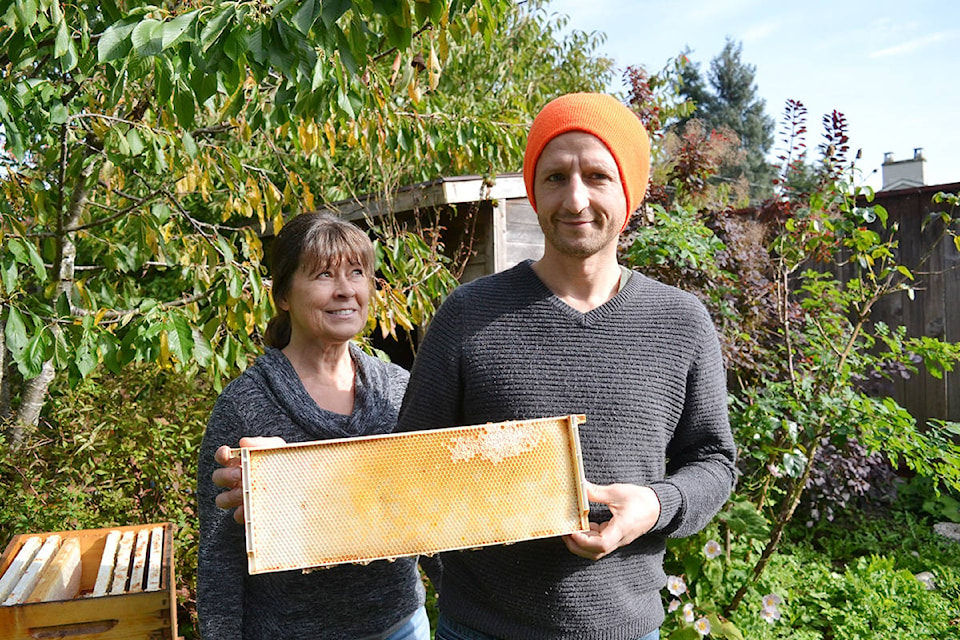White Rock resident Marlene Fuhrmann’s backyard was buzzing with activity this summer, but two weeks ago an eerie silence left her in tears.
Since April, the sounds in Fuhrmann’s lush backyard garden included the low hum of some 20,000 honeybees at work.
The colony, however, started to show signs of distress near the end of September. Within a week, the bees were dead.
Fuhrmann and her son Antonio Marvuglia, both first-time beekeepers, removed thousands of dead bees from the hive, which – located in the 14200-block of North Bluff Road in White Rock – had produced about 150-pounds of honey for the family. Fuhrmann described the loss as devastating.
Unsure of what they did wrong, the amateur beekeepers went online to find some answers.
Many of the honeybees died with their tongues sticking out, which, they read, is a sign of pesticide poisoning. Following the discovery, Fuhrmann wrote a letter-to-the-editor to Peace Arch News, calling on the City of White Rock and City of Surrey to investigate the use of pesticides.
“We went on the internet and we didn’t do anything wrong. It was pesticide that was the clear indication. We read about all of the disease and everything else. When they die with their tongues out, it’s a pesticide application of some sort,” Fuhrmann said.
SEE ALSO: Farmers ponder impact of alternatives to pesticides being banned
Although the internet research may have pointed to pesticide poisoning, Kwantlen Polytechnic University professor and honeybee researcher Cameron Lait suspected there was more to the story.
After hearing a summary of Fuhrmann’s experience, Lait offered to visit her property and investigate first-hand the cause of the deaths. He said it’s unusual for a colony to collapse at this time of the year, which piqued his interest.
Lait and a PAN reporter visited Fuhrmann’s garden Monday morning. The hives had been cleared of the dead bees, leaving little evidence of what might have gone wrong.
Fortunately, Fuhrmann took several high-quality photographs of the dead honeybees before they were discarded. The images showed the protruding tongues.
Lait inspected the photo and returned it with a number of red circles highlighting little clumps in the background that – to the untrained eye – appeared to be specks of dirt.
The little clumps turned out to be a much more insidious invader.
The photo was evidence of a “staggeringly high” population of Varroa mites. These mites feed on the energy stores of bees and weaken them to the point that they’re lethargic and can no longer feed themselves, even if there is plenty of food available, Lait explained.
A protruding tongue, Lait said, can also be a sign of starvation. However, he added that Fuhrmann’s bees were not starved.
And the timing was perfect, as Varroa mite populations peak around the same time as Fuhrmann lost her colony.
Typically, Lait said, it isn’t a singular issue that wipes out a colony, but a multitude of problems that stack against the bees’ best interest.
“I really, strongly feel that it was Varroa mite that did you in,” Lait told Fuhrmann while standing over the empty hive. “That was the tipping factor.”
However, Lait told Fuhrmann that the possibility of pesticide poisoning is something that cannot be ignored.
“You’re living in an urban area, people have gardens, they have ornamentals they have pesticides on. People need to be aware of the potential effect it has, not just on honeybees, but on all pollinators.”
SEE ALSO: The bee pot thickens
Testing dead honeybees in a laboratory is the only way to prove poisoning.
Lait said he doesn’t recall ever seeing confirmed pesticide poisoning happening in September or October, as that’s not typically when pesticide is used.
However, he has seen the results of pesticide poisoning in agricultural fields, typically when flowers were blooming in late spring or early summer. In those cases, the colony was dead within a day or two after pesticides were sprayed.
Some beekeepers, he added, refuse to pollinate blueberry fields for this reason.
Systemic pesticides are particularly dangerous, he added.
“The problem is when you start dealing with systemic pesticides, because they get up into the plant tissue. It’s not the nectar that carries the poison, it’s actually the pollen,” Lait said, adding that honeybees can forage on plants up to seven kilometres away.
A “very strong advocate” for finding alternatives to pesticide use, Lait said he was unable to confirm a diagnosis for Fuhrmann’s collapsed hive.
To protect honeybees, Fuhrmann said residents can do their part by carefully timing pesticide application, which is one of the most important steps towards harm reduction.
“The rule of thumb is wait until all of the blossoms drop and don’t ever, ever spray anything near a beehive. It’s common sense,” he said.
Lait told Fuhrmann not to be discouraged by the loss of the colony, adding that “it happens to the best of people.”
SEE ALSO: Plight of the honeybee
Asked for his opinion about beekeeping as a hobby, Lait told PAN he encourages everyone who’s interested to give it a try, but education is paramount.
“The best way to learn is to join a bee club. We’ve got bee clubs all over the place… Before you get your own hives, I recommend going to a bee club and just attending the meetings, talk to beekeepers, learn as much as you can and then, when you’re ready, jump in.”
Lait offered a word of caution when using the internet as a source for beekeeping information.
“The internet has much misleading information and abundant speculative posts, often by non-professionals so we need to be very careful where we source,” Lait wrote in an email.
According to 2016 data from Statistics Canada, there are 2,640 beekeepers in British Columbia. Statistics Canada estimates that up to $5.5 billion in additional crop value is made possible through the pollination provided by beekeepers.
aaron.hinks@peacearchnews.com
Like us on Facebook and follow us on Twitter
